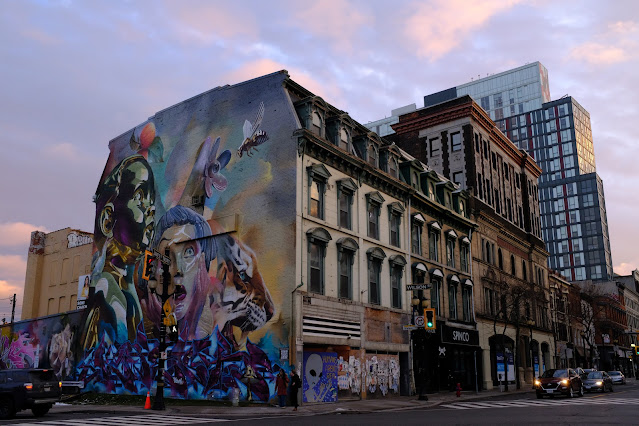In July of this year, I was in Hamilton, Ontario and had the pleasure of attending three performances that were part of the Hamilton Fringe Festival. https://hftco.ca/hamilton-fringe-festival/
Of these performances, the one that had the greatest impact on me was a play, "3 Hours, 10 Minutes" written and directed by Raymond Beauchemin. https://www.raymondbeauchemin.com/
I recently attended a repeat performance of the play presented as part of the Art + Music + Food Festival at the Art Gallery of Hamilton. https://www.artgalleryofhamilton.com/ What can I say about this play? I liked it so much, I saw it twice!
 |
| With Playwright/Director Raymond Beauchemin, "3 Hours, 10 Minutes" at the Art Gallery of Hamilton |
The essence of the play revolves around a New York Times article which challenged the readers to spend 5 to 10 minutes looking at a piece of art rather than the usual average of about 15 seconds. A man, responding to this challenge, becomes so engrossed in a piece of art, In this case, the Lawren Harris piece, "Grey Day in Town" that he spends 3 hours and 10 minutes looking at the painting in a gallery. He is eventually joined by a woman who starts viewing the painting as well and they strike up a conversation.
 |
| Actor Mark Gamache, "3 Hours, 10 Minutes" with the painting "Grey Day in Town" by Lawren S. Harris, at the Art Gallery of Hamilton |
 |
| With Actor Melissa Murray-Mutch "3 Hours, 10 Minutes" at the Art Gallery of Hamilton |
I don't think that I'm giving away too much when I say that the conversation transcends the discussion of a painting and becomes very human. The appreciation of the painting, in a way, becomes analogous to our appreciation of one another as humans.
At the Art Gallery of Hamilton presentation of the play, there was a discussion and q&a session complete with the original painting in the room. Before the session began, Raymond Beauchemin (playwright and director) and Melissa Murray-Mutch (actor in the play) were discussing a detail in the painting and at one point Raymond had his hand out pointing to said detail. I should have had my camera ready! It would have been a cool shot!
I laughed as I said to them that after writing and directing the play, as well as performances and endless rehearsals, they should know that painting better than any two people in the world. Yet here they were, still discussing details about it! I'm not sure if this was a case of art imitating life or life imitating art!
The play hit home for me on a number of levels. In one way, I could almost consider myself it's target demographic. I mean, as a photographer and creative, I present my vision in both digital and printed form. As both a creator and consumer of content, I'm more than well aware of the attention span of most people looking at images or reading written copy in this digitally deluged world.
I liked how the play made the connection between art and humanity. While 3 hours, 10 minutes may seem like an excessively long time to spend gazing at a painting, it may well be what it takes to really come to know and appreciate the piece. Similarly, it requires more than a quick glance and a passing acknowledgement to come to know and appreciate a fellow human being. Perhaps the way that we appreciate art has a direct correlation to our appreciation of one another.
If you get a chance to see this play, I'd definitely recommend it. It may change the way you see and appreciate art. Hell, it may change the way you see and appreciate humanity! In the words of "the man" character in the play, "It's really something!"
...more later



















.JPG)